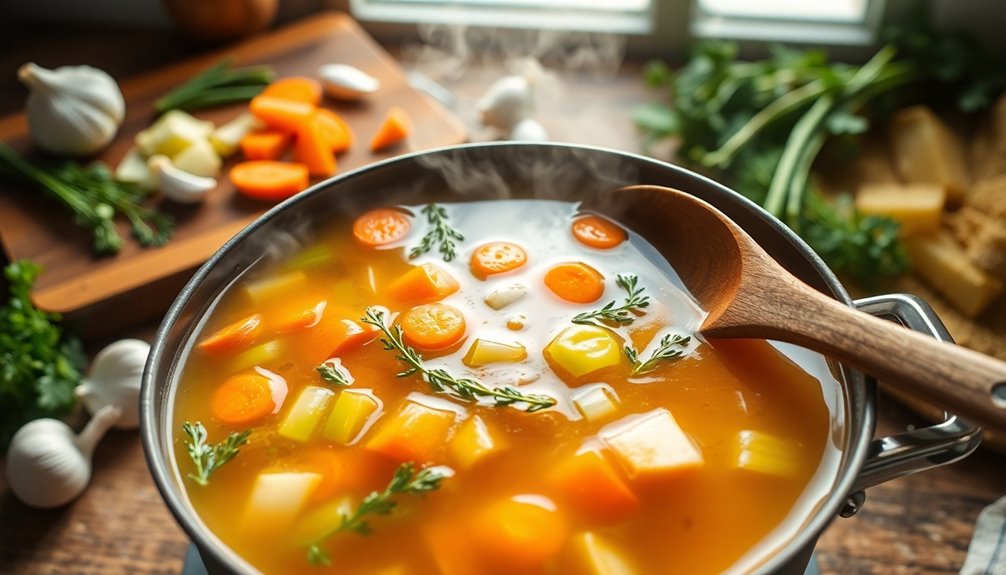Vegetable broth is a flavorful, nutrient-packed base made by simmering veggies like onions, garlic, carrots, and celery. It's a great way to use up kitchen scraps and reduce waste. Plus, it offers versatility in countless dishes. You can enhance its flavor with herbs and spices, but be careful to avoid bitter vegetables. Homemade broth not only improves your meals but also supports your health. Keep exploring, and you'll discover countless ways to make the most of this culinary staple.
History
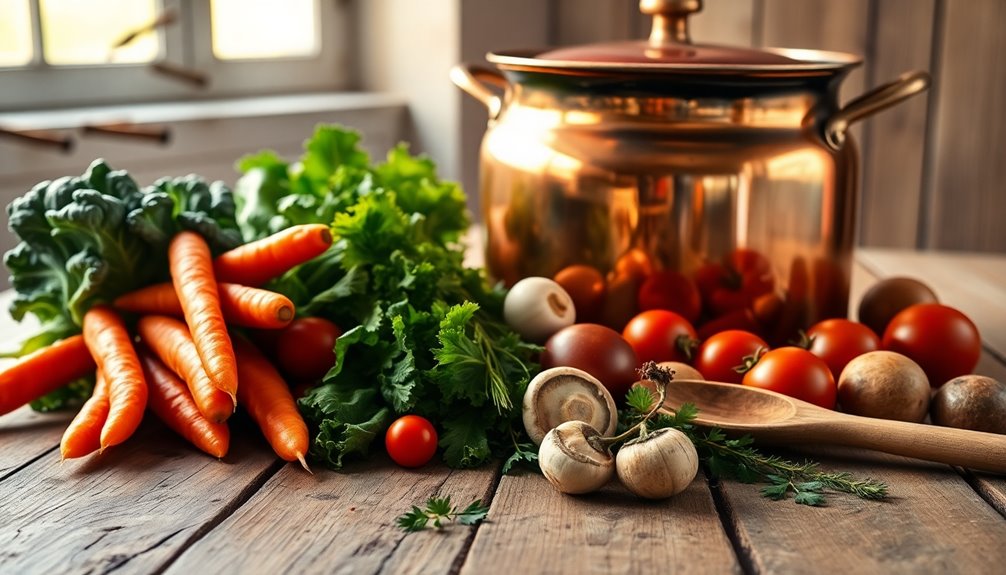
Vegetable broth, which has its roots in ancient culinary traditions, emerged from the simple practice of simmering vegetables in water to extract their flavors. Home cooks showcased their resourcefulness by utilizing leftover vegetables and scraps, aiming to minimize waste. This practice reflected a sustainable cooking approach that remains relevant today.
By the 19th century, with the rise of vegetarianism and health food movements, vegetable broth became popular as a nutritious alternative to meat-based broths. In the late 20th century, homemade vegetable broth surged in popularity, aligning with the growing trend towards plant-based diets.
Today, it's celebrated not just for its culinary versatility but also for its health benefits, being rich in vitamins, minerals, and antioxidants from the variety of vegetables used.
Recipe
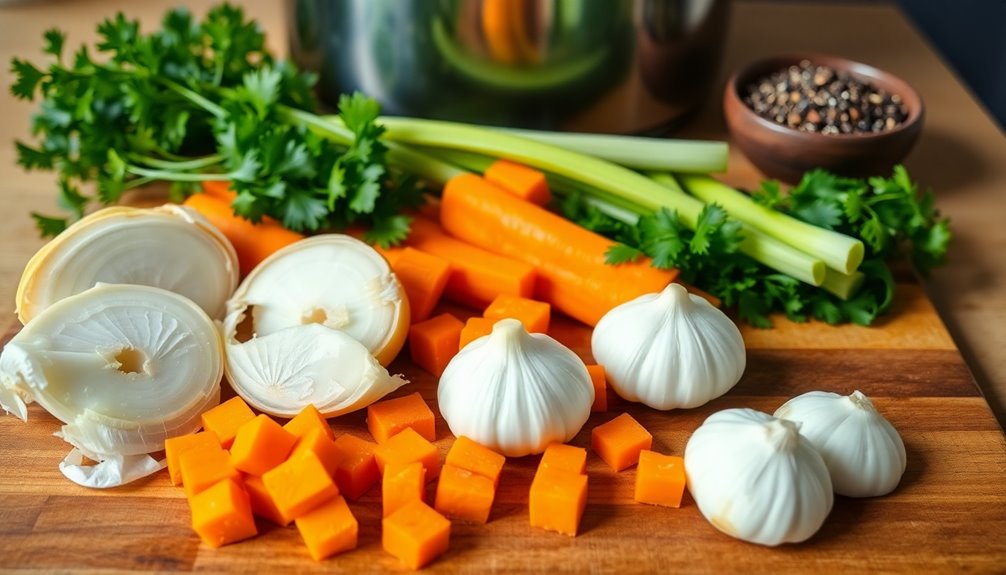
To start, gather your favorite aromatic vegetables and herbs. The combination of onions, garlic, carrots, and celery is classic for building a flavorful base. You can customize the recipe by adding herbs such as thyme and parsley, which contribute to the broth's overall depth. Additionally, using protein-rich ingredients can enhance the nutritional profile of your dishes. Vegetable broth is also low in calories while providing essential nutrients, making it a great option for weight management.
Remember to steer clear of strong-flavored vegetables like cabbage and broccoli, as they can introduce unwanted bitterness to your broth. With just an hour of simmering, you can transform these simple ingredients into a delightful liquid that will enhance your culinary creations.
Ingredients:
- 2 onions, quartered
- 4 cloves garlic, smashed
- 2 carrots, chopped
- 2 celery stalks, chopped
- 1 handful fresh parsley
- 1 teaspoon dried thyme
- 10 cups water
- Salt and pepper to taste
To prepare the vegetable broth, combine all the ingredients in a large pot and cover them with 10 cups of water. Bring the mixture to a boil over medium-high heat, then reduce the heat to low and let it simmer uncovered for about 1 hour.
Skim off any foam that rises to the surface during the cooking process. After an hour, strain the broth through a fine-mesh sieve or cheesecloth into another pot or bowl, discarding the solids. Season the liquid with salt and pepper to taste, and your homemade vegetable broth is ready to use.
When making vegetable broth, it's helpful to note that you can easily experiment with different vegetables and herbs according to your personal preferences. Additionally, using freshly squeezed juices can add a unique flavor to your broth.
Feel free to store any leftover broth in airtight containers and freeze it for up to 1 month. This makes it a convenient option for quick meal prep later on. Just thaw in the refrigerator overnight or reheat directly from the freezer when you're ready to use it!
Cooking Steps
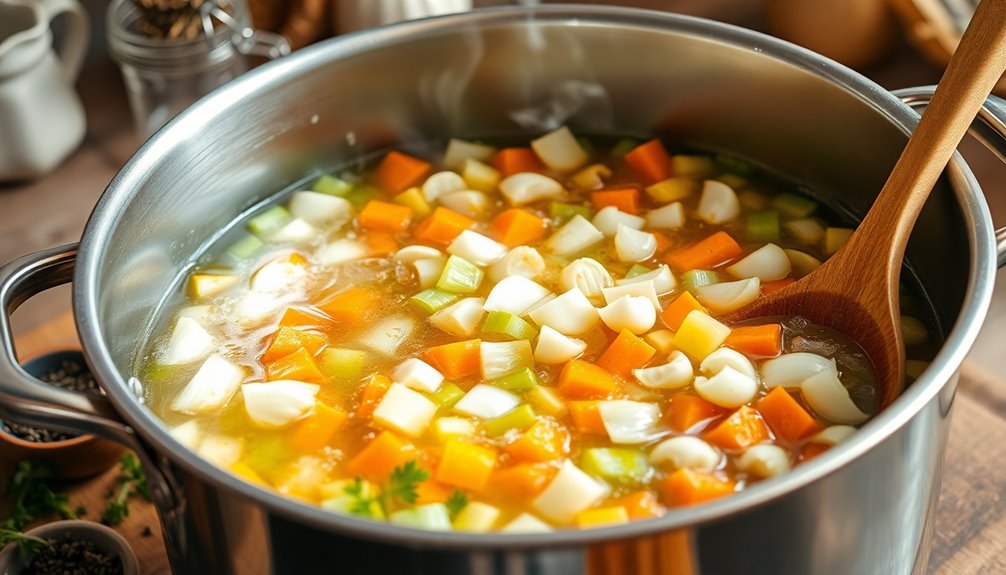
To make a flavorful vegetable broth, start by chopping fresh vegetables finely and sautéing them with aromatics and spices. Once they're softened, you'll add water and let the mixture simmer for at least 30 minutes. Additionally, you can enhance the broth by incorporating nutrient-rich vegetables that will deepen the flavor profile, such as tropical fruits that can provide a unique twist. Including a variety of raw foods can also boost the broth's nutritional content. Finally, strain the broth through a sieve, taste it, and adjust the seasoning to your liking.
Step 1. Chop Fresh Vegetables Finely
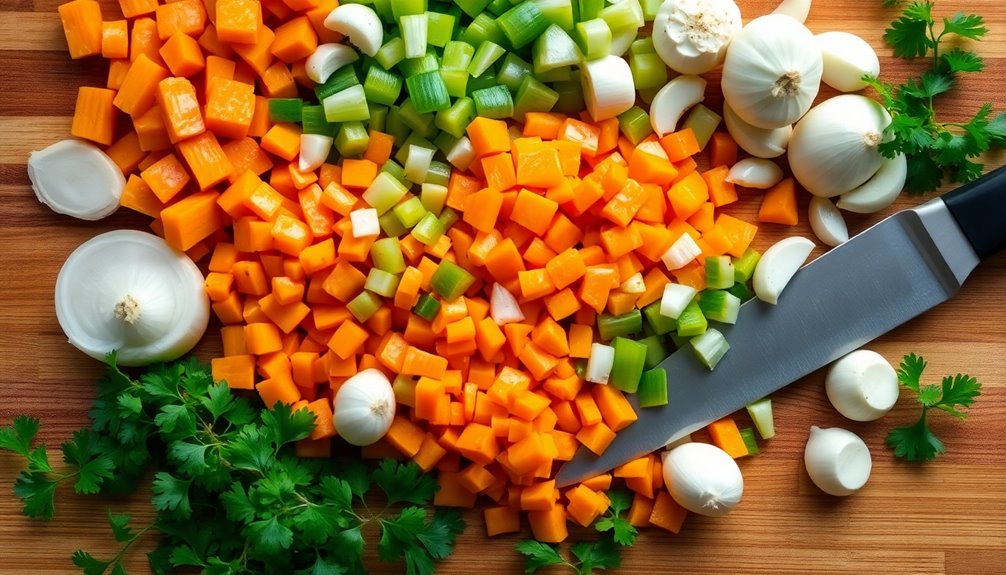
Chop fresh vegetables finely to enhance their browning and flavor, which is vital for creating a rich broth. When finely chopping, aim for uniform pieces, ideally around 1/4-inch in size, to ensure even cooking and optimal flavor extraction during simmering. Grapes are toxic to dogs, so it's essential to keep any harmful ingredients out of your broth. Additionally, using unsalted butter in your broth can add richness without overwhelming the flavors.
Don't forget to include vegetable skins and scraps, like onion and garlic skins; they add extra flavor and nutrients to your broth. Avoid strong-flavored vegetables such as cabbage and mustard greens, as they can overpower the broth's taste. Additionally, incorporating fresh vegetables can contribute essential nutrients, making your broth even more nourishing.
If you're dealing with a large quantity of fresh vegetables, using a food processor can save you time. This careful preparation will set the foundation for a delicious, nourishing broth that highlights the best of your ingredients.
Step 2. Add Aromatics and Spices

As you prepare your vegetable broth, adding aromatics and spices is crucial for building a rich flavor profile. Start by finely chopping aromatics like onions, garlic, carrots, and celery, then sauté them in oil or water for about five minutes to enhance their flavors.
For depth, toss in fresh herbs such as thyme, parsley, and bay leaves during the simmering process. To boost umami, consider adding dried mushrooms, ginger, or lemongrass. Whole spices like black peppercorns can introduce a gentle spiciness without overpowering the broth.
Roasting your aromatics and vegetables beforehand can elevate their natural sweetness and depth, ensuring your broth is packed with flavor, while avoiding bitter vegetables like cabbage or broccoli for balance. Additionally, incorporating anti-inflammatory ingredients such as turmeric or ginger can provide extra health benefits to your broth.
Step 3. Simmer for 30 Minutes
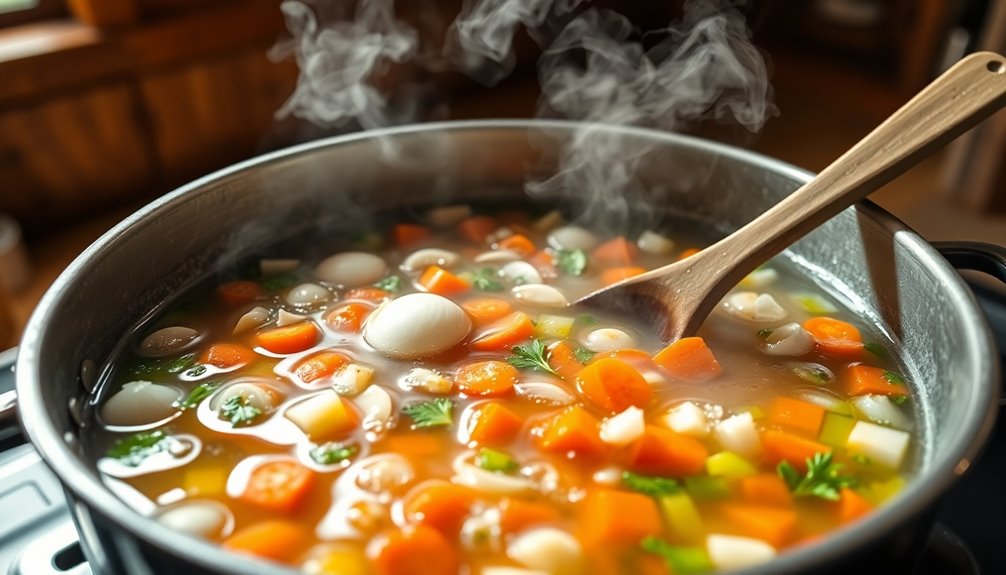
Once you've sautéed your aromatics to bring out their flavors, it's time to focus on simmering the broth.
Add filtered water to your pot and bring it to a boil. Once boiling, reduce the heat to a low simmer. Aim for at least 30 minutes, but if you can, let it simmer for up to an hour. This allows the flavors to meld beautifully.
Keep the pot loosely covered to retain moisture while letting steam escape, which enhances concentration. Remember, maintaining a low simmer prevents a cloudy broth and ensures better flavor extraction from your vegetable scraps.
After simmering, you'll be ready to strain the broth, achieving a clear, homemade liquid that's packed with deliciousness.
Step 4. Strain Broth Through a Sieve

After simmering your broth, it's time to strain it for that perfect, clear liquid.
Gather a fine mesh strainer and place it over a large bowl or pot. Carefully pour your vegetable broth through the sieve, ensuring that the flavorful liquid separates from the vegetable scraps and herbs.
To maximize broth yield, press down gently on the solids with a spoon or spatula to extract any remaining liquid.
For an even clearer broth, consider lining the sieve with cheesecloth or a coffee filter before straining to catch finer particles.
Once done, discard the solids, as they won't contribute any further flavor to your broth.
Enjoy the delicious, aromatic liquid you've created!
Step 5. Taste and Adjust Seasoning

With your broth strained and ready, it's time to taste and adjust the seasoning.
Start by tasting the broth after simmering for at least 30 minutes to gauge its flavor. Gradually add salt, tasting as you go, to enhance the overall flavor without overpowering it.
If you're looking for a savory umami boost, consider incorporating nutritional yeast. Should the broth still lack depth, a splash of soy sauce or a dash of vinegar can elevate the flavor profile without adding calories.
Remember, always strain the broth before adjusting seasonings to ensure a clear liquid, free from bits of vegetables that could affect the taste.
Enjoy crafting a deliciously seasoned broth that satisfies your palate!
Final Thoughts
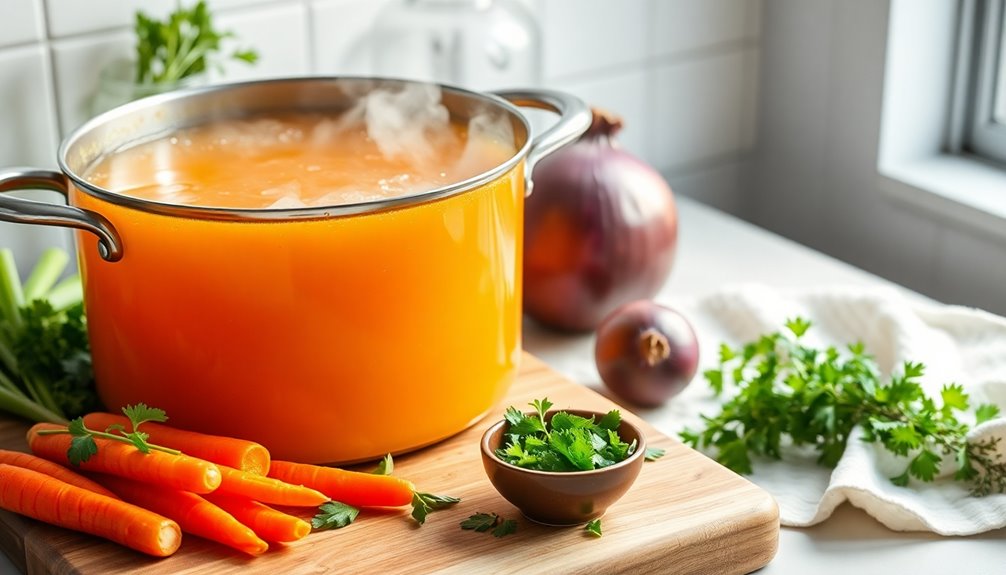
Making homemade vegetable broth is a rewarding experience that combines sustainability with flavor. By using kitchen scraps and aromatic vegetables like onions, garlic, carrots, and celery, you create a nutrient-rich soup base that's both economical and delicious.
Adding herbs such as thyme and parsley enhances the depth of flavor, while optional ingredients like roasted vegetables or dried mushrooms introduce a rich umami flavor. This versatile broth can be frozen for up to a month, making it easy to incorporate into your meals whenever you need it.
Just remember to avoid bitter vegetables, as they can detract from your broth's overall taste. Enjoy the satisfaction of crafting your own broth and elevate your cooking with this simple yet effective technique.
Frequently Asked Questions
What Is Veggie Broth Made Of?
Did you know that nearly 80% of the flavor in veggie broth comes from just a few key ingredients?
It's typically made by simmering aromatic vegetables like onions, garlic, carrots, and celery. You can spice it up with fresh herbs, like thyme and parsley, plus some dried mushrooms or tomatoes for richness.
Just steer clear of bitter veggies like broccoli to keep the flavor balanced. After about 30 minutes, you'll have a delicious broth!
Is Vegetable Stock the Same as Vegetable Broth?
You might wonder if vegetable stock and vegetable broth are the same.
They're often used interchangeably, but there are slight differences.
Stock tends to be more concentrated and unseasoned until you use it in a dish, while broth can be lighter and may come pre-seasoned for immediate use.
Both enhance flavors in soups and stews, so you can use either based on your preference or what you have on hand.
Is Vegetable Broth Healthy?
You're likely wondering if vegetable broth's healthy. It is! It's low in calories, packed with essential vitamins and minerals, and can be a great way to add flavor without excess calories.
If you make it at home, you can customize it with nutrient-dense veggies and herbs. Plus, it helps keep you hydrated.
Just remember, incorporating vegetable scraps can boost its fiber content, further supporting your digestive health.
What Not to Put in Vegetable Broth?
When making a broth, you should avoid adding cruciferous vegetables like broccoli and cabbage, as they can create a bitter taste.
Starchy veggies, such as potatoes and corn, might make it overly sweet and thick.
Dominant flavors from beets and bell peppers can overwhelm the mix, while excess tomato seeds and skins can introduce bitterness.
Strong herbs and dried spices aren't recommended either, as they can alter the freshness and overall flavor profile negatively.
